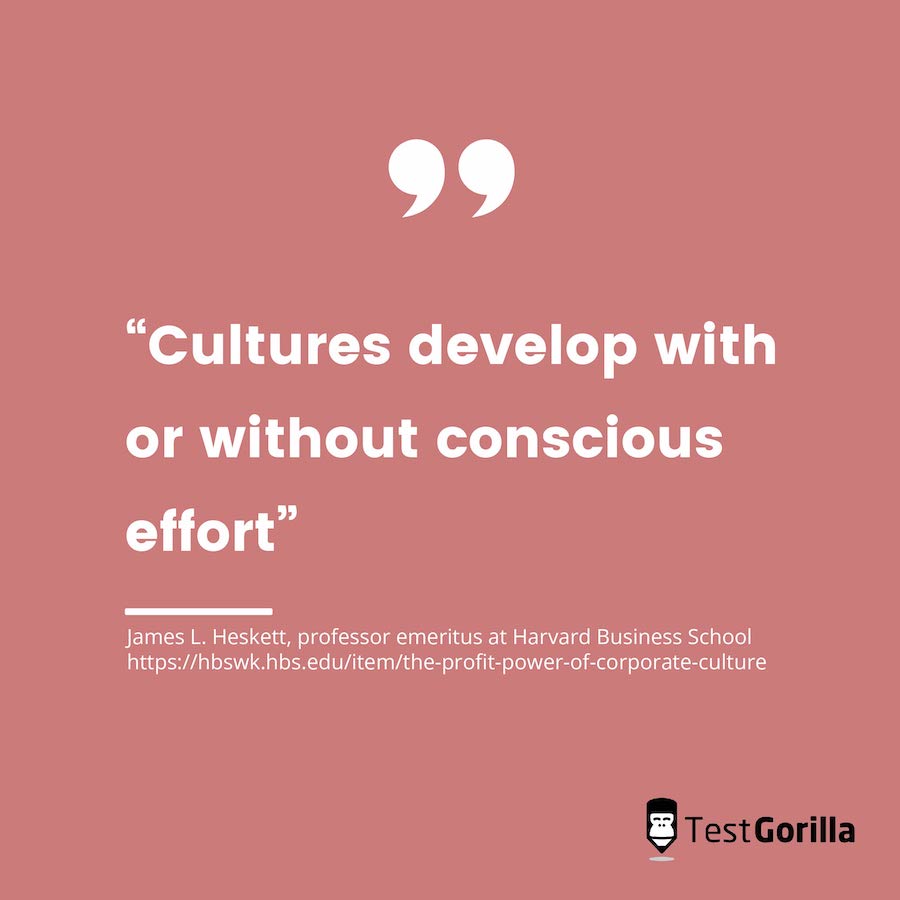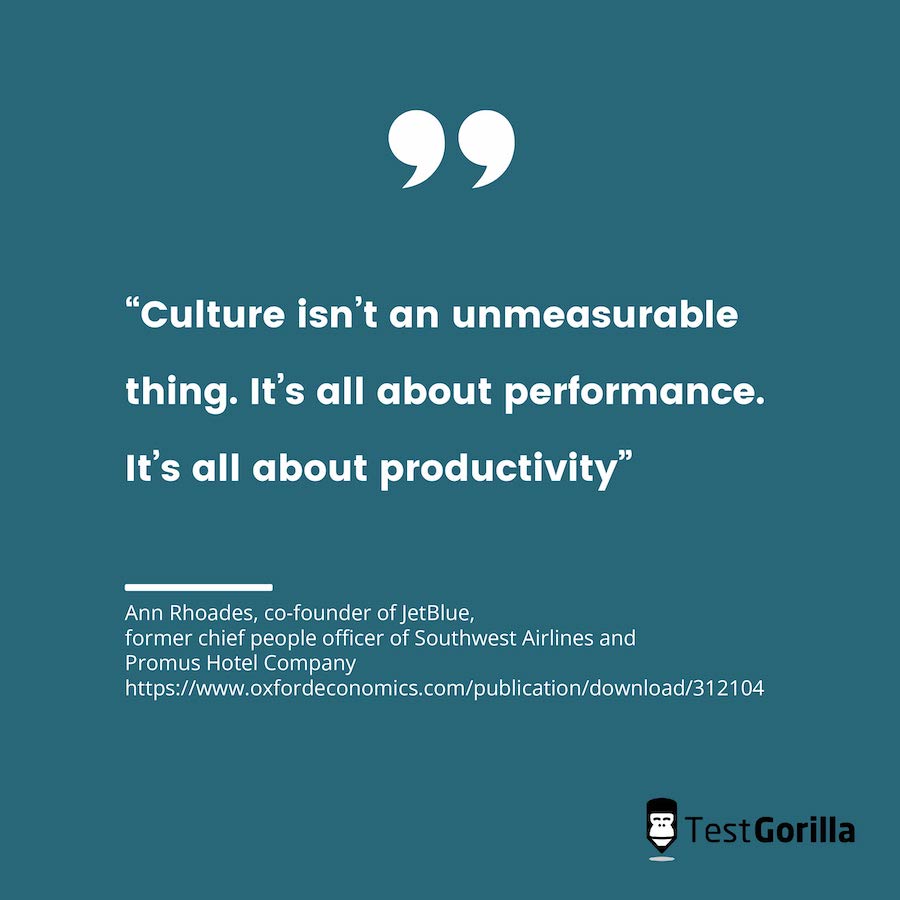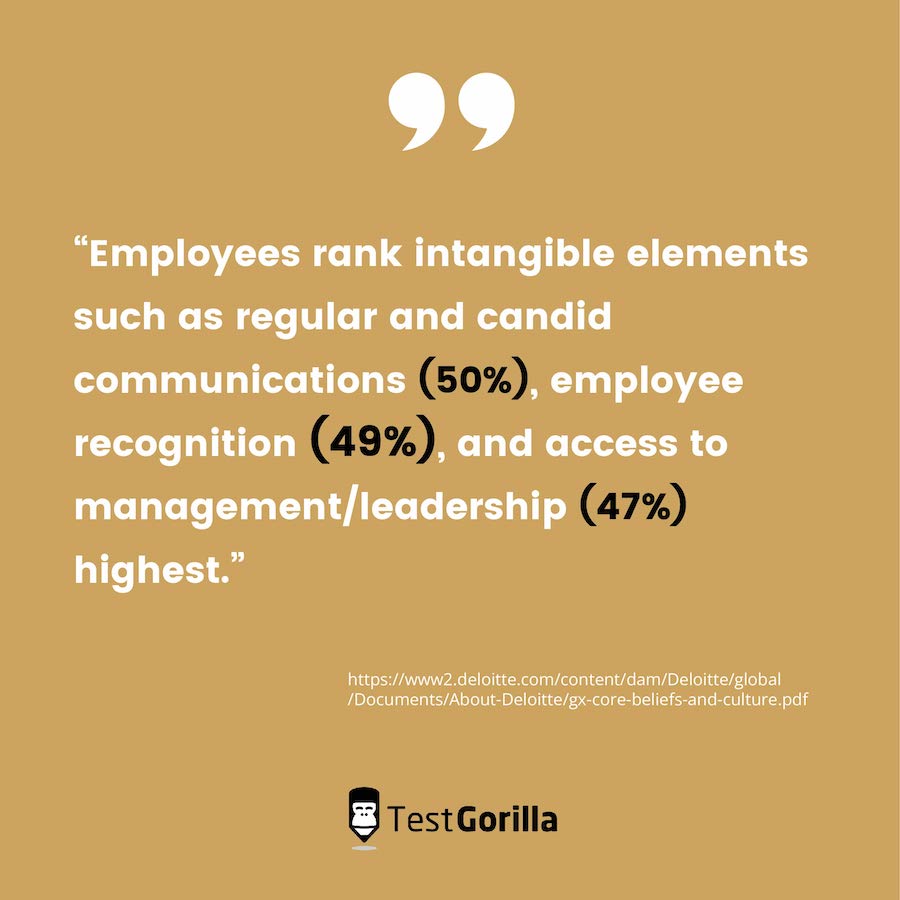Is your organization a place your colleagues dread coming to every day?
If you answered with a frustrated “yes”, there’s hope for evolving your workplace culture. Your workplace can become a place where people feel comfortable and fulfilled.
How?
By using healthy culture-add hiring practices, you can create a positive workplace culture for you and your colleagues.
In this article, we’ll explore practical ways you can develop your company culture.
In the end, you’ll get a free PDF guide to using TestGorilla for creating a positive workplace culture.
Table of contents
How do you define workplace culture?
Workplace culture is a living concept. As your company grows and changes, the culture evolves alongside it.
You can describe your company culture by noticing how people act within the organization.
Have a look at a few of the questions you can ask when defining your organizational culture:
How and what do teams and individuals communicate?
What happens when there is conflict?
Are people motivated to come to work?
How is workplace behavior regulated by standards of integrity?
When do teammates exit the company?
“Which traits in colleagues add value to the workplace?”
Do managers encourage their teams?
Who has the authority to act in leadership positions?
Workplace culture shows people how they are expected to behave within an organization.
That culture is defined by company values and actions that align with those values.
Can you develop workplace culture in a remote work environment?
Yes! Workforce location is not the primary or sole deciding factor in workplace culture.
Creating a remote workplace can be a strategic way to promote company values such as freedom, wellbeing, and autonomy.
Two types of positive workplace culture
Before you strategize for a healthier workplace, you’ll need to define a realistic vision of what that looks like. Let’s take a quick look at two types of healthy workplace culture that you can work towards.
Adhocracy culture: This workplace focuses on creativity, innovation, and flexibility. Leaders of an adhocracy are seen as inspiring pioneers who aren’t afraid to take risks.
Learning culture: In this type of workplace, team members are encouraged to advance themselves through knowledge, opportunities, and skills.
Why you should implement a healthy workplace culture
Imagine being part of a workplace where people feel appreciated, fulfilled, and inspired.
What do you think the productivity levels are like in that organization?
How do you think loyalty and commitment affect that company’s revenue?
Employee happiness increases productivity. A study by economists at the University of Warwick found that people who are happy at work are 12% more productive.
Financial benefits of a positive workplace culture
In 2019, Grant Thornton and Oxford Economics published “Return on Culture”, a study providing measurable connections between organizational culture and revenue.
Employee engagement drives profitability: Public companies with an extremely healthy culture are 2.5 times more likely to report notable stock-price increases over their previous year.
Healthy workplace culture drives revenue: Companies that reported an extremely healthy culture are 1.5 times more likely to experience a 15% revenue increase for at least three years in a row.
Decide which culture metrics matter most
Before we understand how to improve workplace culture, we need to know how to measure it.
Here are three metrics that show how your organizational culture is performing:
Rate of employee turnover: Employee turnover measures how many people leave the company in a specific timeframe and the conditions under which they leave.
Number of employee referrals: This number measures the amount of hiring referrals from your existing staff.
Employee engagement rate: This metric shows how committed employees are to your organization. It is best determined by conducting regular internal surveys.
Once you have chosen the key metrics for your workplace culture, you can analyze your current performance and create realistic goals.
Strategies to improve workplace culture
Let’s look at two pivotal steps to developing a positive workplace culture.
Analyze your existing organizational culture
Start by taking a deep look at the quality of your organizational culture. Ask the hard questions to reveal the honest answers you need. For example:
Does the environment and social structure create a friendly working environment for everyone – or just a few people?
Which steps do people take when there is conflict?
How do managers treat their team members?
Is there room for everyone to grow?
Can each team member experience a positive work environment?
What are productivity levels like in each department? Why?
Conducting this internal research is best done by an unbiased party with no stake in the company.
You can always bring in a qualified consultant or firm to assess your workplace culture.
Ask your employees which aspects of culture matter most to them
During the process of analyzing your workplace culture, it’s key to ask your workforce what matters most to them in the workplace.
What makes your teammates feel fulfilled?
Are they achieving work-life balance in a healthy way? Why or why not?
How do your co-workers like to be recognized for their work?
Why are these things important to your colleagues?
Asking these questions at the beginning of your company culture analysis will prevent disconnect later on. Your workforce will feel heard and valued when you deliver a company culture that is in line with their professional and personal values.
Once you understand your employees’ values, you can hire for culture add – bringing in more diverse, qualified candidates who are excited to commit to your organization.
Free PDF Guide: Hire candidates who enhance your positive company culture
Our science-backed tests help organizations like yours hire qualified people who add to the company culture.
We invite you to understand how a culture-add test can help you deliver an unbiased hiring process.
You can use our culture-add test in:
The start of your hiring process
Behavioral interviews
Team-building exercises
To start exploring, download your free PDF guide to asking unbiased culture-add questions.
hbspt.forms.create({ region: "na1", portalId: "6821985", formId: "89ab33c4-e209-4925-9840-8e746d9876fc" });
Related posts
Hire the best candidates with TestGorilla
Create pre-employment assessments in minutes to screen candidates, save time, and hire the best talent.
Latest posts
The best advice in pre-employment testing, in your inbox.
No spam. Unsubscribe at any time.

Hire the best. No bias. No stress.
Our screening tests identify the best candidates and make your hiring decisions faster, easier, and bias-free.
Free resources
This checklist covers key features you should look for when choosing a skills testing platform
This resource will help you develop an onboarding checklist for new hires.
How to assess your candidates' attention to detail.
Learn how to get human resources certified through HRCI or SHRM.
Learn how you can improve the level of talent at your company.
Learn how CapitalT reduced hiring bias with online skills assessments.
Learn how to make the resume process more efficient and more effective.
Improve your hiring strategy with these 7 critical recruitment metrics.
Learn how Sukhi decreased time spent reviewing resumes by 83%!
Hire more efficiently with these hacks that 99% of recruiters aren't using.
Make a business case for diversity and inclusion initiatives with this data.
























